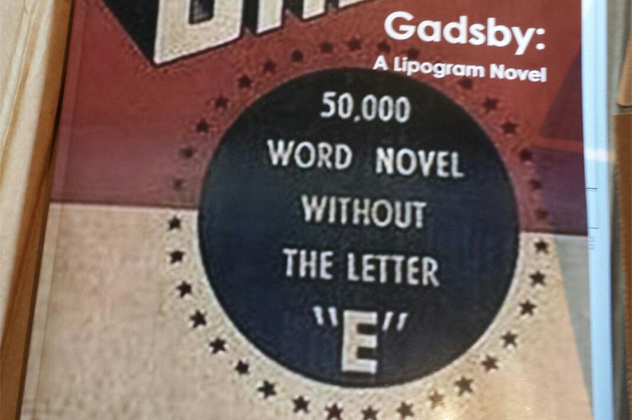 Creepy
Creepy  Creepy
Creepy  Technology
Technology 10 Scientific Breakthroughs of 2025 That’ll Change Everything
 Our World
Our World 10 Ways Icelandic Culture Makes Other Countries Look Boring
 Misconceptions
Misconceptions 10 Common Misconceptions About the Victorian Era
 Mysteries
Mysteries 10 Strange Unexplained Mysteries of 2025
 Miscellaneous
Miscellaneous 10 of History’s Most Bell-Ringing Finishing Moves
 History
History 10 Great Escapes That Ended Right Back in Captivity
 Weird Stuff
Weird Stuff 10 Fascinating Things You Might Not Know About Spiders
 Food
Food 10 Everyday Foods You Didn’t Know Were Invented by the U.S. Military
 History
History 10 Odd Things Colonial Americans Kept at Home
 Creepy
Creepy 10 More Representations of Death from Myth, Legend, and Folktale
 Technology
Technology 10 Scientific Breakthroughs of 2025 That’ll Change Everything
 Our World
Our World 10 Ways Icelandic Culture Makes Other Countries Look Boring
Who's Behind Listverse?

Jamie Frater
Head Editor
Jamie founded Listverse due to an insatiable desire to share fascinating, obscure, and bizarre facts. He has been a guest speaker on numerous national radio and television stations and is a five time published author.
More About Us Misconceptions
Misconceptions 10 Common Misconceptions About the Victorian Era
 Mysteries
Mysteries 10 Strange Unexplained Mysteries of 2025
 Miscellaneous
Miscellaneous 10 of History’s Most Bell-Ringing Finishing Moves
 History
History 10 Great Escapes That Ended Right Back in Captivity
 Weird Stuff
Weird Stuff 10 Fascinating Things You Might Not Know About Spiders
 Food
Food 10 Everyday Foods You Didn’t Know Were Invented by the U.S. Military
 History
History 10 Odd Things Colonial Americans Kept at Home
10 Pieces Of Writing That Only Exist To Annoy People
As we’ve mentioned before, the English language is full of quirks that allow us to craft Frankenstein-esque sentences that adhere to the stringent rules of grammar—despite looking like a typo that even a blind editor would catch. Today, we wanted to explore a similar idea and present to you 10 examples of words, sentences, and writing that seemingly exist for no other reason than to demonstrate just how silly language can be.
10The Longest Word In The English Language

We’re going to be honest, our spellchecker just gave up when we tried typing “pneumonoultramicroscopicsilicovolcanoconiosis,” and we can’t really blame it. Clocking in at a mind-boggling 45 letters long, it’s one of the single longest words in the entire English language, dwarfing its better-known cousin, “antidisestablishmentarianism,” by 17 whole letters.
So what does it mean? Well, the word can technically be used to describe a very specific medical condition that can arise as a result of inhaling fine silica ash or dust, but you’d be hard pressed to find a doctor who’s even aware of the word because the condition described above already has a much shorter medical name: pneumoconiosis.
“Pneumonoultramicroscopicsilicovolcanoconiosis” was actually coined in 1935 by a guy named Everett Smith in a deliberate attempt to create a very long word. Smith came up with the word by combining a number of Latin terms before presenting it to the National Puzzlers’ League (NPL) during a presentation on “the ever-growing length of medical words.” Smith, who was the president of the NPL at the time, neglected to mention to any of the people present that the word wasn’t actually a medical term or that he was the one who’d made it up. Nevertheless, the word was able to “somehow” sneak its way into a dictionary a few years later—officially making it a real word, much to the annoyance of everyone who wasn’t in the NPL. Of course, this led to the sadly unproven rumor that they were the ones responsible for it being added to the dictionary.
9Gadsby

In the literary world, there is a technique known as “constrained writing,” which is basically where the author of a piece of work intentionally decides to limit themselves in some way—for example, by making every second line rhyme with the first or making it so that every sentence starts with a different letter of the alphabet. Gadsby is perhaps one of the most famous examples of this style of writing because it doesn’t use the letter “E” once, despite being over 50,000 words long.
The author of Gadsby, Earnest Wright, wrote the novel in 1936 after his friends insisted that such a feat would be impossible without butchering the English language. Spurred on by the skepticism of his friends, Wright went home, tied down the “E” key on his typewriter, and wrote his obscure masterpiece in just under six months. Sadly, Wright died just two months after he finished the novel and a freak fire ended up burning almost every copy of his book.
Luckily, a few copies of the book did survive and, thanks to the wonders of copyright, it’s now in the public domain. That means that anyone can read it for free, which we highly recommend—if only for the part where a wedding cake is referred to as “an astonishing loaf of culinary art.” Genius.
8Semordnilap

A semordnilap is roughly described as “a word, phrase, or sentence which can be read in reverse with a different meaning.”
For example, the word “dog” when written backward becomes “god,” which is obviously a very different word, unless you happen to follow the most adorable religion ever. The word was coined by renowned word nerd Dimitri Borgmann to describe a special kind of word that wasn’t quite a palindrome (a word or phrase that reads the same backward as it does forward) but still had utility as a linguistic curiosity.
Eagle-eyed readers may have already noticed that the word “semordnilap” itself is a semordnilap of the word “palindromes,” meaning that “semordnilap” is a self-referential word, or a word that can be used to define itself. To make this more confusing, despite semordnilaps being incredibly rare in common English, there are at least four words to describe them, including “anadromes,” “volvograms,” “heteropalindromes,” and our personal favorite, “backwords.”
We don’t think anything sums up how stupidly complex the English language is more than there being five different words to describe a kind of word that becomes a new word when you write it backward, one of which becomes another word when it’s written backward.
7‘Lion-Eating Poet In The Stone Den’

Moving away from English for a moment, we’d like to discuss a delightful Chinese riddle called “The Lion-Eating Poet in the Stone Den.” The riddle was written by a Chinese linguist called Yuen Ren Chao in the 20th century as an example of how ridiculous it was to phonetically translate Classical Chinese into English.
Although the poem makes perfect sense on paper in Classical Chinese, which is traditionally a written language, if you were to ask someone to read it aloud and then transcribed what you heard in English, it would consist of nothing but the word “shi” repeated several dozen times with varying degrees of inflection attached to each word.
This is because the riddle is written entirely using homophonic characters that can be interpreted differently depending on their pronunciation. However, because the piece is written solely using different pronunciations of a single word, it quickly becomes unintelligible to everyone except those versed in the language when it’s read out loud. This more than proves Ren Chao’s point that Classical Chinese requires a more robust method of translation than simply writing down what you hear.
6That That Is Is That That Is Not Is Not Is That It It Is

The above sequence of words was put together primarily to test people on their grasp of proper punctuation. Although at first glance the string of words looks like one of our editors got a little too carried away with CTRL+C, with a few well-placed periods, a single comma, and a question mark, it suddenly makes sense and can be read as: “That that is, is. That that is not, is not. Is that it? It is.”
The word string, for all intents and purposes, exists for two reasons: to demonstrate the importance of punctuation and to make other people feel stupid for not being able to figure it out. An example of the latter occurs quite prominently in the 1968 film Charly, in which the eponymous character uses the sentence to demonstrate his intellectual superiority after being given surgery to increase his intelligence.
5Esquivalience

There’s an oft-repeated joke that posits the question: “If a word was spelled incorrectly in the dictionary, how would anyone know about it?” As interesting as that thought is, we have a better question for you: If the people editing a dictionary slipped in a made-up word, how would we know which one it was?
As strange as it’s going to sound, that exact scenario happened a few years ago in 2005 when Henry Alford, an editor for The New Yorker, heard rumblings that the New Oxford American Dictionary had a made-up word hidden somewhere in its “E” section. After an exhaustive search that involved questioning some of the foremost experts on lexicography, Alford found a single entry in the second edition of the NOAD that didn’t sit right with him or the experts he’d consulted: “esquivalience.”
According to the NOAD, “esquivalience” is defined as “The willful avoidance of one’s official responsibilities.” When Alford approached the NOAD to ask about where the word had come from, he was surprised to learn that it had in fact been invented by one of the NOAD’s editors specifically to catch plagiarists. The editors reasoned that since the word “esquivalience” only existed within the confines of their dictionary, if it appeared in another dictionary, they could be pretty sure that the competitor had plagiarized some of their other definitions as well.
In other words, the NOAD invented a word just to catch plagiarists and then defined that word as being really bad at your job, just to rub it in if they ever got caught.
4‘I Am The Walrus’
In 1967, John Lennon received a letter from a young fan that brought the undeniable beginnings of a smirk to his face. According to the letter—which had been sent by a student at the high school from which he’d graduated—classes of students were poring over the lyrics to Beatles songs in an attempt to discern what they meant. Spying an opportunity for mischief, Lennon sat down with the singular goal of writing the most intentionally obtuse song he could think of. The result was “I Am The Walrus.”
The song features nonsensical lyrics like “sitting on a cornflake” and “yellow matter custard dripping from a dead dog’s eye,” the latter of which was inspired by a song Lennon would sing in school to annoy his teachers. The song also features a sound clip from a production of King Lear that Lennon insisted be included in the recording for no other reason than the fact that it was on the radio when the band was in the studio. As the final icing on the cake, Lennon then asked that the sound guy distort his voice as much as possible to make the lyrics that much harder to hear.
Unsurprisingly, the song was immediately dissected by fans who found a host of hidden double meanings behind the expertly crafted lyrics in a song that was written by Lennon specifically to stop people from doing exactly that. It’s almost like people don’t remember that, along with being an amazing lyricist, John Lennon also had a sense of humor. Remember, this is the same guy who answered the question “What’s your favorite type of girl?” with “My wife.”
3Zzxjoanw

According to the person who invented this word, it’s pronounced “shaw.”
The word was first defined in 1903 by Rupert Hughes in his book The Musical Guide, according to which a zzxjoanw is a type of Maori drum. Hughes’s definition of the word, its spelling, and its pronunciation went unchallenged for 70 years, even managing to find its way into a dictionary before it was revealed that Hughes made up the word just to see if people would believe him.
What makes this doubly hilarious is that the first three letters of the word aren’t even in the Maori alphabet, meaning that Hughes’s hoax should have realistically been debunked in minutes. Instead, though, it outlived him, and even today there are still hardcore Scrabble players who insist that it’s a real word.
2Hiybbprqag

Unlike some of the other words we introduced you to today, there is no agreed-upon way to pronounce “Hiybbprqag,” because it exists solely as a nonsense word that was created with perhaps the greatest intention of all—annoying Microsoft.
Ever since Microsoft launched Bing in 2009, Google has accused the service of ripping off its search results but was never able to prove it. Undeterred, Google employees created a number of nonsense words like “Hiybbprqag” and linked them to totally unrelated webpages so that searching for the word on Google would lead you to a single page that had no connection to the search term whatsoever.
As Google expected, within a few weeks, Bing suddenly started returning the exact same results as Google whenever a user tried to search for “Hiybbprqag” using the service, even though the two pages were completely unrelated save for the artificial connection Google themselves had made. Unsurprisingly, Microsoft denied that they were copying Google’s search results, which fooled just about nobody. The story was quickly picked up by the media and was even featured on The Colbert Report. As a final insult to Microsoft, if you now search for “Hiybbprqag” using Bing, one of the first results is a Wikipedia page discussing the accusations that Bing steals from Google.
1Cromulent

Fans of the Simpsons will probably immediately recognize the word “cromulent” as one of the show’s most popular and enduring neologisms. The word first appeared in the 1996 episode “Lisa the Iconoclast,” where it was used to describe another popular Simpsons neologism, “Embiggen.” The word was coined by long-time Simpsons writer David X. Cohen and was used in the episode specifically because it kind of sounded like a real word.
The irony is that, while the word was coined with the intention of annoying fans by forcing them to reach for a dictionary to see if the word was actually real, it became so popular that it has now entered the mainstream lexicon and has in effect become a real word. Which, if we say so ourselves, is a perfectly cromulent point to end on.
To see more from Karl, you can follow him on Twitter, Facebook, and Tumblr. You know, if you’re into that sort of thing.








